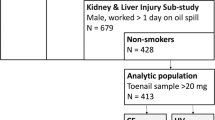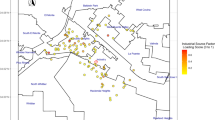Abstract
Background
Scientists use biomarkers to evaluate metal exposures. One biomarker, toenails, is easily obtained and minimally invasive, but less commonly used as a biomarker of exposure. Their utility will depend on understanding characteristics of their variation in a population over time. The objective of our study is to describe the correlation of toenail metal levels many years apart among participants in the VA Normative Aging Study (NAS).
Methods
Toenail clippings from 825 participants of the NAS from year 1992 to 2014 were analyzed for lead (Pb), Arsenic (As), Cadmium (Cd), Manganese (Mn), and Mercury (Hg). We utilized linear mixed models to assess correlation between toenail metal concentrations in multiple toenail samples from the same subject collected years apart and identified the optimal covariance pattern by likelihood ratio tests and Akaike’s information criterion (AIC). Correlations among different metals were described using Spearman correlations.
Results
The average number of times toenail samples were collected from each subject ranged from 1.63 (Hg) to 2.04 (As). The average number of years between toenails collected per subject ranged from 4.73 (SD = 2.44) (Mn) to 5.35 (SD = 2.69) (Hg). Metal concentrations had slightly different correlation patterns over time, although for all metals correlations decreased with increasing time between samples. Estimated correlations over a 3-year span were highest for toenail Pb (0.68) and Hg (0.67), while As, Cd, and Mn had lower correlations of 0.49, 0.44, and 0.47, respectively. Even across a 6-year span, the lowest correlation was 0.35 (Cd).
Conclusions
Our results suggest that Pb, As, Cd, Mn, and Hg levels from toenail clippings can reasonably reflect exposures over several years in elderly men in the NAS. Even across 6 years, toenail metal levels were generally well correlated among NAS participants. As such, they may be useful as biomarkers of exposure in epidemiological studies of similar populations.
This is a preview of subscription content, access via your institution
Access options
Subscribe to this journal
Receive 6 print issues and online access
$259.00 per year
only $43.17 per issue
Buy this article
- Purchase on Springer Link
- Instant access to full article PDF
Prices may be subject to local taxes which are calculated during checkout



Similar content being viewed by others
References
Garland M, Morris JS, Rosner BA, Stampfer MJ, Spate VL, et al. Toenail trace element levels as biomarkers: reproducibility over a 6-year period. Cancer Epidemiol Biomark Prev. 1993;2:493–7.
LeBlanc A, Dumas P, Lefebvre L. Trace element content of commercial shampoos: impact on trace element levels in hair. Sci Total Environ. 1999;229:121–4.
Hunter MorrisJ, Chute C, Kushner E, Colditz G, Stampfer M, et al. Predictors of selenium concentration in human toenails. Am J Epidemiol. 1990;132:114.
Longnecker PM, Stram OD, Taylor RP, Levander AO, Howe AM, Veillon YC, et al. Use of selenium concentration in whole blood, serum, toenails, or urine as a surrogate measure of selenium intake. Epidemiology. 1996;7:384–90.
Ovaskainen ML, Virtamo J, Alfthan G, Haukka J, Pietinen P, Taylor PR, et al. Toenail selenium as an indicator of selenium intake among middle-aged men in an area with low soil selenium. Am J Clin Nutr. 1993;57:662.
Swanson CA, Longnecker MP, Veillon C, Howe M, Levander OA, Taylor PR, et al. Selenium intake, age, gender, and smoking in relation to indices of selenium status of adults residing in a seleniferous area. Am J Clin Nutr. 1990;52:858–62.
Hinwood AL, Sim MR, Jolley D, de Klerk N, Bastone EB, Gerostamoulos J, et al. Hair and toenail arsenic concentrations of residents living in areas with high environmental arsenic concentrations. (Environmental Medicine). Environ Health Perspect. 2003;111:187.
Karagas MR, Stukel TA, Morris JS, Tosteson TD, Weiss JE, Spencer SK, et al. Skin cancer risk in relation to toenail arsenic concentrations in a US population-based case-control study. Am J Epidemiol. 2001;153:559–65.
Karagas MR, Tosteson TD, Blum J, Klaue B, Weiss JE, Stannard V, et al. Measurement of low levels of arsenic exposure: a comparison of water and toenail concentrations. Am J Epidemiol. 2000;152:84–90.
Levit EK, Scher RK. Basic science of the nail unit. In: Freinkel RK, Woodley D, editors. The biology of the skin. New York: Parthenon PubGroup; 2001. p. 101–10.
Slotnick MJ, Nriagu JO. Validity of human nails as a biomarker of arsenic and selenium exposure: a review. Environ Res. 2006;102:125–39.
Steven Morris J, Stampfer MJ, Willett W. Dietary selenium in humans toenails as an indicator. Biol Trace Elem Res. 1983;5:529–37.
Weller RB, Hunter HJA, Mann MW. Clinical dermatology. 5th ed. Wiley; Oxford, United Kingdom 2014.
Grashow R, Zhang J, Fang SC, Weisskopf MG, Christiani DC, Cavallari JM. Toenail metal concentration as a biomarker of occupational welding fume exposure. J Occup Environ Hyg. 2014;11:397–405.
Sakamoto M, Chan HM, Domingo JL, Oliveira RB, Kawakami S, Murata K. Significance of fingernail and toenail mercury concentrations as biomarkers for prenatal methylmercury exposure in relation to segmental hair mercury concentrations. Environ Res. 2015;136:289–94.
Laohaudomchok W, Lin X, Herrick RF, Fang SC, Cavallari JM, Christiani DC, et al. Toenail, blood, and urine as biomarkers of manganese exposure. J Occup Environ Med. 2011;53:506–10.
Mordukhovich I, Wright RO, Hu H, Amarasiriwardena C, Baccarelli A, Litonjua A, et al. Associations of toenail arsenic, cadmium, mercury, manganese, and lead with blood pressure in the normative aging study. Environ Health Perspect. 2012;120:98–104.
Hunter DJ, Morris JS, Stampfer MJ, Colditz GA, Speizer FE, Willett WC. A prospective study of selenium status and breast cancer risk. JAMA. 1990;264:1128–31.
Maasland DHE, Schouten LJ, Kremer B, van den Brandt PA. Toenail selenium status and risk of subtypes of head-neck cancer: the Netherlands Cohort Study. Eur J Cancer. 2016;60:83–92.
Gulson BL. Nails: concern over their use in lead exposure assessment. Sci Total Environ. 1996;177:323–7.
Hinners T, Tsuchiya A, Stern A, Burbacher T, Faustman E, Mariën K. Chronologically matched toenail-Hg to hair-Hg ratio: temporal analysis within the Japanese community (U.S.). Environ Health. 2012;11:81.
Bell B, Rose CL, Damon A. The normative aging study: an interdisciplinary and longitudinal study of health and aging. Int J Aging Human Dev. 1972;3:5–17.
Willett W, Sampson L, Stampfer M, Rosner B, Bain C, Witschi J, et al. Reproducibility and validity of a semiquantitative food frequency questionnaire. Am J Epidemiol. 1985;122:51–65.
Fitzmaurice GM. Applied longitudinal analysis. . Hoboken, N J: Wiley-Intersci; 2004. p. 506–xix+p.
Pirkle JL, Brody DJ, Gunter EW, Kramer RA, Paschal DC, Flegal KM, et al. The decline in blood lead levels in the United States. The National Health and Nutrition Examination Surveys (NHANES). JAMA. 1994;272:284–91.
Barbosa F, Tanus-Santos JE, Gerlach RF, Parsons PJ. A critical review of biomarkers used for monitoring human exposure to lead: advantages, limitations, and future needs. Environ Health Perspect. 2005;113:1669–74.
Bouchard MF, Bellinger DC, Weuve J, Matthews-Bellinger J, Gilman SE, Wright RO, et al. Blood lead levels and major depressive disorder, panic disorder, and generalized anxiety disorder in US young adults. Arch Gen Psychiatry. 2009;66:1313–9.
Cheng Y, Schwartz J, Sparrow D, Aro A, Weiss ST, Hu H. Bone lead and blood lead levels in relation to baseline blood pressure and the prospective development of hypertension: the normative aging study. Am J Epidemiol. 2001;153:164–71.
Rhodes D, Spiro A, Aro A, Hu H. Relationship of bone and blood lead levels to psychiatric symptoms: the normative aging study. J Occup Environ Med. 2003;45:1144–51.
Schwartz J, Tsaih SW, Korrick S, Fau - Schwartz J, Schwartz J, Fau - Lee ML, et al. Lead, blood pressure, and cardiovascular disease in men and women. Environ Health Perspect. 1991;91:71–5.
Wongwit W, Kaewkungwal J, Chantachum Y, Visesmanee V. Comparison of biological specimens for manganese determination among highly exposed welders. Southeast Asian J Trop Med Public Health. 2004;35:764–9.
Centers for Disease Control and Prevention. Manganese - ToxFAQs. Prepared by the Agency for Toxic Substances and Disease Registry. 2012. CAS# 7439-96-5.
Linus Pauling Institute OSU. Manganese: sources. Linus Pauling Institute; Oregon, USA 2014.
Centers for Disease Control and Prevention. Mercury - ToxFAQs. Prepared by the Agency for Toxic Substances and Disease Registry. 1999. CAS# 7439-97-6.
NRC. Toxicological effects of methylmercury. Washington, DC: National Academies Press; 2000.
Joshi A, Douglass CW, Kim H-D, Joshipura KJ, Park MC, Rimm EB, et al. The relationship between amalgam restorations and mercury levels in male dentists and nondental health professionals. J Public Health Dent. 2003;63:52–60.
Dekker LH, Boer JM, Stricker MD, Busschers WB, Snijder MB, Nicolaou M, et al. Dietary patterns within a population are more reproducible than those of individuals. J Nutr. 2013;143:1728–35.
Jankovic N, Steppel MT, Kampman E, de Groot LC, Boshuizen HC, Soedamah-Muthu SS, et al. Stability of dietary patterns assessed with reduced rank regression; the Zutphen Elderly Study. Nutr J. 2014;13:30.
Movassagh EZ, Baxter-Jones ADG, Kontulainen S, Whiting SJ, Vatanparast H. Tracking dietary patterns over 20 years from childhood through adolescence into young adulthood: the Saskatchewan Pediatric Bone Mineral Accrual Study. Nutrients. 2017;9:990.
Weismayer C, Anderson JG, Wolk A. Changes in the stability of dietary patterns in a study of middle-aged Swedish women. J Nutr. 2006;136:1582–7.
Sharma B, Singh S, Siddiqi NJ. Biomedical implications of heavy metals induced imbalances in redox systems. BioMed Res Int. 2014;2014:1–26.
Bjorkman L, Lundekvam BF, Laegreid T, Bertelsen BI, Morild I, Lilleng P, et al. Mercury in human brain, blood, muscle and toenails in relation to exposure: an autopsy study. Environ Health. 2007;6:30.
Keil A, Richardson D. Reassessing the link between airborne arsenic exposure among Anaconda copper smelter workers and multiple causes of death using the parametric g-formula. Environ Health Perspect. 2017;125:608.
Hopps HC. The biologic bases for using hair and nail for analyses of trace elements. Sci Total Environ. 1977;7:71–89.
Willett W. Nutritional epidemiology: issues and challenges. Int J Epidemiol. 1987;16:312–7.
Davis MA, Signes-Pastor AJ, Argos M, Slaughter F, Pendergrast C, Punshon T, et al. Assessment of human dietary exposure to arsenic through rice. Sci Total Environ. 2017;586:1237–44.
Rosner B, Spiegelman D, Willett WC. Correction of logistic regression relative risk estimates and confidence intervals for random within-person measurement error. Am J Epidemiol. 1992;136:1400.
Acknowledgements
We thank all the participants and dedicated staff of the VA Normative Aging Study. The VA Normative Aging Study is supported by the Cooperative Studies Program/ERIC, Department of Veterans Affairs, and is a component of the Massachusetts Veterans Epidemiology Research and Information Center (MAVERIC). We also thank Anna Kosheleva at the Harvard T.H. Chan School of Public Health for her help as the data manager.
Author information
Authors and Affiliations
Corresponding author
Ethics declarations
Funding
U.S. Centers for Disease Control and Prevention, National Institute of Occupational Health and Safety, Education and Research Center training grant T42 OH008416 (Alexander Wu), National Institutes of Health, National Institute of Environmental Health Sciences grant ES05257 and P30 00002 (Marc Weisskopf), and National Institutes of Health R01 ES015172 (Chitra Amarasiriwardena, Joel Schwartz) and R01 ES027747 (Joel Schwartz).
Conflict of interest
The authors declare that they have no conflict of interest.
Electronic supplementary material
Rights and permissions
About this article
Cite this article
Wu, A.C., Allen, J.G., Coull, B. et al. Correlation over time of toenail metals among participants in the VA normative aging study from 1992 to 2014. J Expo Sci Environ Epidemiol 29, 663–673 (2019). https://doi.org/10.1038/s41370-018-0095-0
Received:
Revised:
Accepted:
Published:
Issue Date:
DOI: https://doi.org/10.1038/s41370-018-0095-0
Keywords
This article is cited by
-
Validation of in vivo toenail measurements of manganese and mercury using a portable X-ray fluorescence device
Journal of Exposure Science & Environmental Epidemiology (2022)



